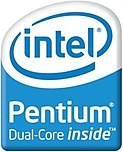Intel Pentium Dual-Core
 |
|
| Produced | From 2006 to 2009 |
|---|---|
| Common manufacturer(s) |
|
| Max. CPU clock rate | 1.3 GHz to 3.4 GHz |
| FSB speeds | 533 MHz to 800 MHz |
| Min. feature size | 65 nm to 45 nm |
| Instruction set | MMX, SSE, SSE2, SSE3, SSSE3, x86-64 |
| Microarchitecture | Core |
| Cores | 2 |
| Socket(s) | |
| Predecessor | Pentium M, Pentium D |
| Successor | Pentium (2009) |
| Core name(s) |
|
The Pentium Dual-Core brand was used for mainstream x86-architecture microprocessors from Intel from 2006 to 2009 when it was renamed to Pentium. The processors are based on either the 32-bit Yonah or (with quite different microarchitectures) 64-bit Merom-2M, Allendale, and Wolfdale-3M core, targeted at mobile or desktop computers.
In terms of features, price and performance at a given clock frequency, Pentium Dual-Core processors were positioned above Celeron but below Core and Core 2 microprocessors in Intel's product range. The Pentium Dual-Core was also a very popular choice for overclocking, as it can deliver high performance (when overclocked) at a low price.
In 2006, Intel announced a plan to return the Pentium trademark from retirement to the market, as a moniker of low-cost Core microarchitecture processors based on the single-core Conroe-L but with 1 MiB of cache. The identification numbers for those planned Pentiums were similar to the numbers of the latter Pentium Dual-Core microprocessors, but with the first digit "1", instead of "2", suggesting their single-core functionality. A single-core Conroe-L with 1 MiB cache was deemed as not strong enough to distinguish the planned Pentiums from the Celerons, so it was replaced by dual-core CPUs, adding "Dual-Core" to the line's name. Throughout 2009, Intel changed the name back from Pentium Dual-Core to Pentium in its publications. Some processors were sold under both names, but the newer E5400 through E6800 desktop and SU4100/T4x00 mobile processors were not officially part of the Pentium Dual-Core line.
...
Wikipedia
